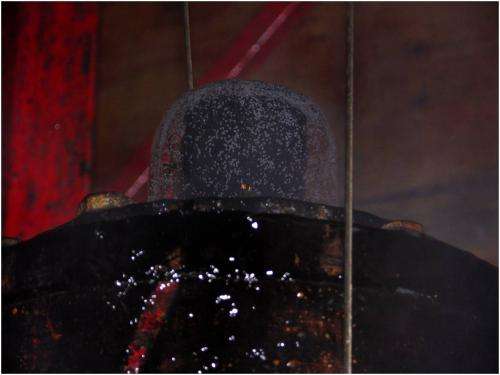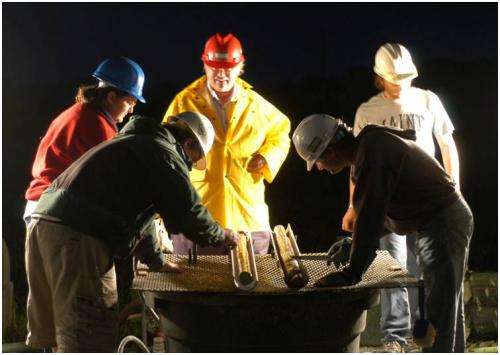November 14, 2013 report
Research shows the North Atlantic became less salty as it grew

(Phys.org) —The water in a 35-million-year-old impact crater beneath Chesapeake Bay, an estuary off the Atlantic Coast of North America, is twice as salty as ocean water, according to a study by Ward E. Sanford and his colleagues at the US Geological Survey (USGS). The research, which appears in Nature, shows that the water in the crater is a remnant of seawater from the Early Cretaceous Period. Sanford and his team believe that the North Atlantic's transition from a closed rift basin to an open ocean caused saline levels to decrease.
Thirty five million years ago, a comet or asteroid struck the Earth, forming the Chesapeake Bay crater. Scientists at the USGS in Cape Charles, Virginia, and the International Continental Drilling Program in Eyreville Neck, Virginia drilled into the crater to extract core material and found standing water trapped inside sediment.
Sanford's team analyzed this water and discovered that its average salinity was 70 per mil, twice as high as that of modern ocean water. At first, the researchers thought that evaporation generated by the heat from the impact would have caused the high salt concentration. However, simulations of the impact revealed it would not have generated enough heat to account for this.
Model simulations, chemical analyses and analyses of isotope ratios showed that the water found in the impact crater had the same composition as water from the Early Cretaceous North Atlantic (ECNA). The researchers concluded that the water from the crater was a remnant of the ECNA and between 140 and 145 million years old.

The team believes the North Atlantic became less salty as it expanded. During the Early Cretaceous, the North Atlantic was a closed rift basin, formed during the breakup of the supercontinent Pangea. As the continents spread apart, the North Atlantic grew wider, eventually becoming an ocean, and water pouring in from newly formed openings would have diluted the salt. The researchers pointed out that as the ocean formed, openings to the ECNA waxed and waned, so salt levels would have fluctuated, although there would have been an overall decline. This is consistent with their findings, which showed that saline levels in the crater water fluctuated with depth, although they increased overall.
Even a small opening would have reduced salt concentrations. Sanford's team believe that by around 100 million years ago, the ocean's salinity was already similar to what it is today.
More information: Evidence for high salinity of Early Cretaceous sea water from the Chesapeake Bay crater, Nature 503, 252–256 (14 November 2013) DOI: 10.1038/nature12714
Abstract
High-salinity groundwater more than 1,000 metres deep in the Atlantic coastal plain of the USA has been documented in several locations, most recently within the 35-million-year-old Chesapeake Bay impact crater. Suggestions for the origin of increased salinity in the crater have included evaporite dissolution, osmosis and evaporation from heating associated with the bolide impact. Here we present chemical, isotopic and physical evidence that together indicate that groundwater in the Chesapeake crater is remnant Early Cretaceous North Atlantic (ECNA) sea water. We find that the sea water is probably 100–145 million years old and that it has an average salinity of about 70 per mil, which is twice that of modern sea water and consistent with the nearly closed ECNA basin. Previous evidence for temperature and salinity levels of ancient oceans have been estimated indirectly from geochemical, isotopic and palaeontological analyses of solid materials in deep sediment cores. In contrast, our study identifies ancient sea water in situ and provides a direct estimate of its age and salinity. Moreover, we suggest that it is likely that remnants of ECNA sea water persist in deep sediments at many locations along the Atlantic margin.
Journal information: Nature
© 2013 Phys.org



















